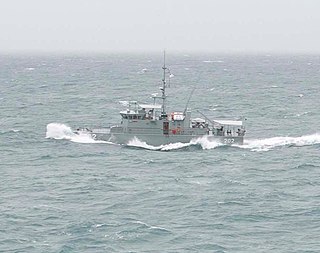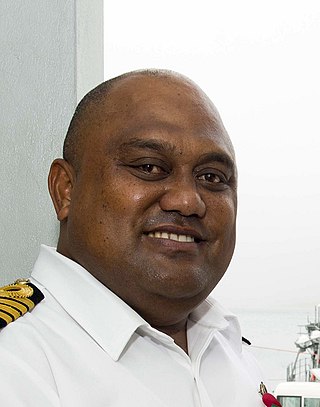
Josaia Voreqe "Frank" Bainimarama is a Fijian politician and former naval officer who served as the prime minister of Fiji from 2007 until 2022. A member of the FijiFirst party, which he founded in 2014, he began his career as an officer in the Fijian navy and commander of the Fijian military. Despite being suspended from Parliament, he served as the opposition leader from 24 December 2022 until 8 March 2023, when he resigned and was replaced by Inia Seruiratu.

The Fiji Infantry Regiment is the main combat element of the Republic of Fiji Military Forces. It is a light infantry regiment consisting of six battalions, of which three are regular army and three are Territorial Force. The regiment was formed with the foundation of the Fijian armed forces in 1920. The regiment, as it is today, goes back to 1978 following Fiji's independence. The Royal Australian Infantry Corps and Royal New Zealand Infantry Regiment conduct yearly training seminars and exercises with the Fiji Infantry Regiment
Since attaining independence from the United Kingdom on 10 October 1970, Fijian history has been marked by exponential economic growth up to 1987, followed by relative stagnation, caused to a large extent by political instability following two military coups in 1987 and a civilian putsch in 2000. This was followed by another military coup in 2006. Rivalry between indigenous Fijians and Indo-Fijians, rather than ideological differences, have been the most visible cleavage of Fijian politics. Later in 2020, Fiji was hit by the global COVID-19 pandemic, which affected the economy and the daily lives of the people.

Major-General Jioji Konousi "George" Konrote, is a Fijian politician and retired Major-General of the Fiji Military who served as the President of Fiji from 2015 to 2021. After commanding a peacekeeping mission in Lebanon, Konrote served as Fiji's High Commissioner to Australia from 2001 to 2006, as Minister of State for Immigration briefly in 2006, and as Minister for Employment Opportunities, Productivity and Industrial Relations from 2014 to 2015. He was the first non-iTaukei president, the first not to be a chief, and the first Seventh-day Adventist to be elected by parliament, as previous presidents were selected by the Great Council of Chiefs.

The Fijian coup d'état of December 2006 was a coup d'état in Fiji carried out by Commodore Frank Bainimarama, Commander of the Republic of Fiji Military Forces (RFMF), against Prime Minister Laisenia Qarase and President Josefa Iloilo. It was the culmination of a political crisis that started the previous year, when the Qarase government introduced three bills to the Fijian Parliament. The Qoliqoli, Land Tribunal, and Reconciliation, Tolerance, and Unity Bills dealt with the ongoing ethnic conflicts in Fiji and the aftermath of the 2000 coup, and were considered to be pro-ethnic Fijian. Bainimarama presented the government with a list of demands on October 16 that included withdrawing the bills. Attempts at negotiation failed and the military launched the coup on 4 December. Parliament was dissolved, Qarase and his cabinet were dismissed, and some civilian officials were placed under house arrest. After the Great Council of Chiefs refused to appoint a cabinet friendly to the military, Bainimarama reached an understanding with Iloilo and reinstated him as President on 4 January 2007. Iloilo then appointed Bainimarama acting Prime Minister in charge of the Interim Cabinet.

Operation Morris Dance was an Australian military operation conducted in May 1987 in response to the first of the 1987 Fijian coups d'état.
Lieutenant Colonel Pita Driti is a former Fijian soldier who played a prominent role in the 2006 Fijian coup d'état. He served as the Land Force Commander of the Republic of Fiji Military Forces, the third most senior position in the Military.

Rear Admiral Viliame Naupoto is a Fijian soldier, politician and former Cabinet Minister. After serving as Commander of the Republic of Fiji Navy, he was appointed as a Minister in the military regime of dictator Frank Bainimarama. He was later appointed commander of the Republic of Fiji Military Forces, before being elected to the Parliament of Fiji in December 2022.
Jone Baledrokadroka is a Fijian academic and former soldier who served briefly as Republic of Fiji Military Forces Land Force Commander in January 2006. He was dismissed from the post after only four days after RFMF Commander Frank Bainimarama accused him of planning a mutiny. He is the son of former senator and Taukei ni Waluvu Ratu Alipate Baledrokadroka and the brother of Senator Adi Lagamu Vuiyasawa. He is also the uncle for New Zealand netballer Erikana Pedersen.

The Guardian-class patrol boats are a class of small patrol vessels designed and built in Australia and provided to small South Pacific Ocean countries as part of the Australian Government's Pacific Maritime Security Program.

RFNS Kula (201) is a Pacific Forum patrol boat operated by Fiji. She was designed and built by Australia. Australia agreed to provide twenty-two patrol boats to twelve of its neighbours and fellow members of the Pacific Forum, after the recently concluded United Nations Convention on the Law of the Sea extended maritime nations' exclusive economic zone to 200 kilometres (110 nmi). Australia provided two other patrol vessels to Fiji, Kikau and Kiro. Australia also provided training and infrastructure.

RFNS Kiro (203) was one of three Pacific Forum patrol boats operated by Fiji. She was the last of the three to be launched, in May 1995, and the first to be retired, when she ran aground and was deemed unsalvable, in 2016.

RFNS Kikau (202) is a Pacific-class patrol boat operated by Fiji. She was designed and built by Australia. Australia agreed to provide twenty-two patrol boats to twelve of its neighbours and fellow members of the Pacific Forum, after the recently concluded United Nations Convention on the Law of the Sea extended maritime nations' exclusive economic zone to 200 kilometres (110 nmi). Australia provided two other patrol vessels to Fiji, Kula and Kiro. Australia also provided training and infrastructure.
HMPNGS Rabaul (01) was the first Pacific Forum patrol vessel to be commissioned, in May 1987. She is not the first vessel of the class to go out of service, because her sister ship from Fiji RFNS Kiro was wrecked in 2016. She arrived in Port Moresby, for disposal, on October 24, 2018. The vessel was named HMPNGS Tarangau.

The Commander of the Republic of Fiji Military Forces is the highest-ranking military officer of in the Republic of Fiji Military Forces, who is responsible for maintaining the operational command of the military. The current commander is Major General Jone Kalouniwai.
RFNS Kacau is a hydrographic survey vessel donated by China to the Republic of Fiji Naval Service in 2019. With the capacity for approximately 30 crewmembers she will be Fiji's largest vessel.

RFNS Savenaca (401) is a Guardian-class patrol boat, being built in Australia for Fiji's Navy. She will replace RFNS Kula, a Pacific Forum patrol vessel provided by Australia in 1994. She will be the seventh vessel of the class to be completed, and the second of two to be delivered to Fiji. She will be commissioned in March or April of 2020.

Humphrey Tawake is a senior officer in the Republic of Fiji Naval Service.

The Fijian Navy was created when Fiji ratified the recently created United Nations Convention on Laws of the Sea. The Convention established that maritime nation had an Exclusive Economic Zone of 200 kilometres, which extended Fiji's waters twentyfold, from 50,000 square miles (130,000 km2) to over 1,000,000 square miles (2,600,000 km2).
Jone Logavatu Kalouniwai is a major general in the Republic of Fiji Military Forces (RFMF) who currently serves as the commander of the Republic of Fiji Military Forces since 16 September 2021. Previously named as director general of National Security and Intelligence, Ministry of Defence and National Security from May 2020 to September 2021, he also served as section commander in Lebanon and instructor at the RFMF Training School.









































